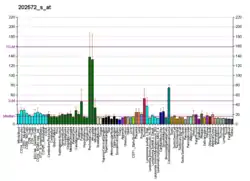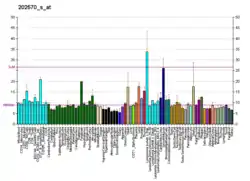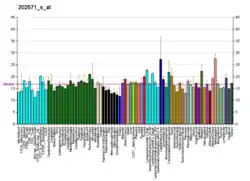DLGAP4
Disks large-associated protein 4 (DAP-4) also known as SAP90/PSD-95-associated protein 4 (SAPAP-4) is a protein that in humans is encoded by the DLGAP4 gene.[5][6]
| DLGAP4 | |||||||||||||||||||||||||
|---|---|---|---|---|---|---|---|---|---|---|---|---|---|---|---|---|---|---|---|---|---|---|---|---|---|
| Identifiers | |||||||||||||||||||||||||
| Aliases | DLGAP4, DAP-4, DAP4, DLP4, SAPAP-4, SAPAP4, discs large homolog associated protein 4, DLG associated protein 4 | ||||||||||||||||||||||||
| External IDs | OMIM: 616191 MGI: 2138865 HomoloGene: 8935 GeneCards: DLGAP4 | ||||||||||||||||||||||||
| |||||||||||||||||||||||||
| |||||||||||||||||||||||||
| |||||||||||||||||||||||||
| |||||||||||||||||||||||||
| Orthologs | |||||||||||||||||||||||||
| Species | Human | Mouse | |||||||||||||||||||||||
| Entrez | |||||||||||||||||||||||||
| Ensembl | |||||||||||||||||||||||||
| UniProt | |||||||||||||||||||||||||
| RefSeq (mRNA) | |||||||||||||||||||||||||
| RefSeq (protein) | |||||||||||||||||||||||||
| Location (UCSC) | Chr 20: 36.31 – 36.53 Mb | Chr 2: 156.61 – 156.76 Mb | |||||||||||||||||||||||
| PubMed search | [3] | [4] | |||||||||||||||||||||||
| Wikidata | |||||||||||||||||||||||||
| |||||||||||||||||||||||||
Function
DAP-4 is a membrane-associated guanylate kinase found at the postsynaptic density in neuronal cells. It is a signaling molecule that can interact with potassium channels and receptors, as well as other signaling molecules. DAP-4 can interact with PSD-95 through its guanylate kinase domain and may be involved in clustering PSD-95 in the postsynaptic density region. The encoded protein is one of at least four similar proteins that have been found. Alternatively spliced transcript variants encoding different isoforms have been found for this gene.[6]
References
- GRCh38: Ensembl release 89: ENSG00000080845 - Ensembl, May 2017
- GRCm38: Ensembl release 89: ENSMUSG00000061689 - Ensembl, May 2017
- "Human PubMed Reference:". National Center for Biotechnology Information, U.S. National Library of Medicine.
- "Mouse PubMed Reference:". National Center for Biotechnology Information, U.S. National Library of Medicine.
- Takeuchi M, Hata Y, Hirao K, Toyoda A, Irie M, Takai Y (Jun 1997). "SAPAPs. A family of PSD-95/SAP90-associated proteins localized at postsynaptic density". J Biol Chem. 272 (18): 11943–51. doi:10.1074/jbc.272.18.11943. PMID 9115257.
- "Entrez Gene: DLGAP4 discs, large (Drosophila) homolog-associated protein 4".
Further reading
- Kim JH, Liao D, Lau LF, Huganir RL (1998). "SynGAP: a synaptic RasGAP that associates with the PSD-95/SAP90 protein family". Neuron. 20 (4): 683–91. doi:10.1016/S0896-6273(00)81008-9. PMID 9581761. S2CID 12247592.
- Chen HJ, Rojas-Soto M, Oguni A, Kennedy MB (1998). "A synaptic Ras-GTPase activating protein (p135 SynGAP) inhibited by CaM kinase II". Neuron. 20 (5): 895–904. doi:10.1016/S0896-6273(00)80471-7. PMID 9620694. S2CID 14655729.
- Nagase T, Ishikawa K, Suyama M, et al. (1999). "Prediction of the coding sequences of unidentified human genes. XIII. The complete sequences of 100 new cDNA clones from brain which code for large proteins in vitro". DNA Res. 6 (1): 63–70. doi:10.1093/dnares/6.1.63. PMID 10231032.
- Kawabe H, Hata Y, Takeuchi M, et al. (1999). "nArgBP2, a novel neural member of ponsin/ArgBP2/vinexin family that interacts with synapse-associated protein 90/postsynaptic density-95-associated protein (SAPAP)". J. Biol. Chem. 274 (43): 30914–8. doi:10.1074/jbc.274.43.30914. PMID 10521485.
- Husi H, Ward MA, Choudhary JS, et al. (2000). "Proteomic analysis of NMDA receptor-adhesion protein signaling complexes". Nat. Neurosci. 3 (7): 661–9. doi:10.1038/76615. hdl:1842/742. PMID 10862698. S2CID 14392630.
- Pei L, Teves RL, Wallace MC, Gurd JW (2001). "Transient cerebral ischemia increases tyrosine phosphorylation of the synaptic RAS-GTPase activating protein, SynGAP". J. Cereb. Blood Flow Metab. 21 (8): 955–63. doi:10.1097/00004647-200108000-00008. PMID 11487731.
- Deloukas P, Matthews LH, Ashurst J, et al. (2002). "The DNA sequence and comparative analysis of human chromosome 20". Nature. 414 (6866): 865–71. doi:10.1038/414865a. PMID 11780052.
- Strausberg RL, Feingold EA, Grouse LH, et al. (2003). "Generation and initial analysis of more than 15,000 full-length human and mouse cDNA sequences". Proc. Natl. Acad. Sci. U.S.A. 99 (26): 16899–903. doi:10.1073/pnas.242603899. PMC 139241. PMID 12477932.
- Riefler GM, Balasingam G, Lucas KG, et al. (2003). "Exocyst complex subunit sec8 binds to postsynaptic density protein-95 (PSD-95): a novel interaction regulated by cypin (cytosolic PSD-95 interactor)". Biochem. J. 373 (Pt 1): 49–55. doi:10.1042/BJ20021838. PMC 1223477. PMID 12675619.
- Ota T, Suzuki Y, Nishikawa T, et al. (2004). "Complete sequencing and characterization of 21,243 full-length human cDNAs". Nat. Genet. 36 (1): 40–5. doi:10.1038/ng1285. PMID 14702039.
- Song B, Yan XB, Zhang GY (2004). "PSD-95 promotes CaMKII-catalyzed serine phosphorylation of the synaptic RAS-GTPase activating protein SynGAP after transient brain ischemia in rat hippocampus". Brain Res. 1005 (1–2): 44–50. doi:10.1016/j.brainres.2004.01.032. PMID 15044063. S2CID 33854259.
- Brandenberger R, Wei H, Zhang S, et al. (2005). "Transcriptome characterization elucidates signaling networks that control human ES cell growth and differentiation". Nat. Biotechnol. 22 (6): 707–16. doi:10.1038/nbt971. PMID 15146197. S2CID 27764390.
- Kimura K, Wakamatsu A, Suzuki Y, et al. (2006). "Diversification of transcriptional modulation: large-scale identification and characterization of putative alternative promoters of human genes". Genome Res. 16 (1): 55–65. doi:10.1101/gr.4039406. PMC 1356129. PMID 16344560.
This article is issued from Wikipedia. The text is licensed under Creative Commons - Attribution - Sharealike. Additional terms may apply for the media files.






